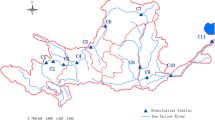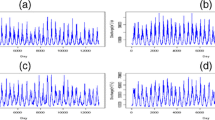Abstract
It is a challenge to develop models that can represent the stochastic behaviour of rivers and basins. Currently used streamflow models were constructed under rigid hypotheses. Hence, these models are limited in their ability to represent nonlinear dependencies and/or unusual distributions. Copulas help overcome these limitations and are being employed widely for modelling hydrological data. For instance, pure copula-based models have been proposed to simulate univariate hydrological series. However, there have been few studies on the use of copulas to model multivariate inflow series. Thus, the aim of this study is to develop a pure copula-based model for simulating periodic multivariate streamflow scenarios, wherein temporal and spatial dependencies are considered. The model was employed in a set of 11 affluent natural energy series from Brazil. We used the model to simulate many scenarios and analyze them through statistical tests such as Levene’s test, the Kolmogorov-Smirnov test, Kupiec test, and t-test. In addition, we investigated the spatial and temporal dependence of the scenarios. Finally, the critical periods of the simulated scenarios were investigated. The results indicated that the proposed model is capable of simulating scenarios that preserve historical features observed in the original data.








Similar content being viewed by others
Notes
Computed from affluent natural streamflows and productibilities of hydropower reservoirs. It can be considered the energy generated from water inflow in a specific location.
The density of a d-dimensional copula is given by \(c(u_{1},...,u_{d})=\frac {\partial ^{d} C(u_{1},...,u_{d})}{\partial u_{1},...,\partial u_{d}}\).
See Aas et al. (2009) for more information.
See Mai and Scherer (2012) for a formal definition.
In Brazil, there are 12 Aggregated Reservoir. However, after a visual inspection, we noted that one RSVR is non-stationary; thus, it was not included.
To help plan the system from a computational perspective, the hydroeletric power plants that make up the system are represented in an aggregated form, through an aggregated reservoir.
References
Aas K, Czado C, Frigessi A, Bakken H (2009) Pair-copula constructions of multiple dependences. Insurance Math Econom 44:182–198
Beare BK, Seo J (2015) Vine copula specifications for stationary multivariate Markov chains. J Time Ser Anal 36:228–246
Bedford T, Cooke RM (2001) Probability density decomposition for conditionally dependent random variables modeled by vines. Ann Math Artif Intell 32:245–268
Bedford T, Cooke RM (2002) Vines: a new graphical model for dependent random variables. Ann Stat 30:1031–1068
Brechmann EC, Czado C (2015) COPAR Multivariate time series modeling using the copula autoregressive model. Appl Stoch Model Bus Ind 31:495–514
Chen L, Singh VP, Guo S, Zhou J, Zhang J (2015) Copula-based method for multisite monthly and daily streamflow simulation. J Hydrol 528:369–384
Hao Z, Singh VP (2013) Modeling multisite streamflow dependence with maximum entropy copula. Water Resour Res 49:7139–7143
Hipel KW, Mcleod AI (1994) Time Series Modelling of Water Resources and Environmental Systems. Elsevier, Amsterdam
Joe H (1996) Families of m-variate distributions with given margins and m(m-1)/2 bivariate dependence parameters, Distributions with fixed marginals and related topics, 120–141, Institute of Mathematical Statistics,L. Ruschendorf and B. Schweizer and M. D. Taylor, 28, Lecture Notes-Monograph Series
Joe H (2014) Dependence Modeling with Copulas. CRC Press, London
Kupiec P (1995) Techniques for verifying the accuracy of risk measurement models. J Deriv 73–84
Lee T, Salas JD (2011) (2011) Copula-based Stochastic simulation of hydrological data applied to Nile River flows. Hydrol Res 42:318–330
Liu Z, Zhou P, Chen X, Guan Y (2015) A multivariate conditional model for streamflow prediction and spatial precipitation refinement. Journal of Geophysical Research:, Atmospheres 120
Mai JF, Scherer M (2012) Simulating Copulas: Stochastic Models, Sampling Algorithms and Applications. Imperial College Press, World Scientific, London
Oliveira FLC, Souza RC (2011) A new approach to identify the structural order of par (p) models. Pesquisa Operacional 31:487–498
Patton A (2013) Copula methods for forecasting multivariate time series. Handbook of Economic Forecasting 2:899–960. Elsevier
Penna DDJ (2009) Definition of the streamflow scenario tree to long-term operation planning, D.Sc Thesis, Department of Electrical Engineering Pontifical Catholic University of Rio de Janeiro, Rio de Janeiro, Brazil
Pereira GAA, Souza RC (2014) Long Memory Models to Generate Synthetic Hydrological Series, Mathematical Problems in Engineering, https://doi.org/10.1155/2014/823046, Article ID 823046, 1-8
Pereira G, Veiga A (2018) PAR (p)-vine copula based model for stochastic streamflow scenario generation. Stoch Env Res Risk A 32:833–842
Pereira GAA, Veiga A, Erhardt T, Czado C (2017) A periodic spatial vine copula model for multi-site streamflow simulation. Electr Power Syst Res 152:9–17
Rasmussen PF, Salas JD, Fagherazzi L, Rassam JC, Bobee B (1996) Estimation and validation of contemporaneous PARMA models for streamflow simulation. Water Resour Res 32:3151–3160
Reddy MJ, Ganguli P (2012) Bivariate flood frequency analysis of Upper Godavari River flows using Archimedean copulas. Water Resour Manag 26:3995–4018
Salas JD, Delleur JW, Yevjevich JW, Lane WL (1980) Applied Modeling of Hydrologic Time Series. Water Resources Publications, First, Michigan
Schepsmeier U, Stoeber J, Brechmann EC, Graeler B, Nagler T, Erhardt T (2017) VineCopula: Statistical Inference of Vine Copulas,R package version 2.1.1, http://CRAN.R-project.org/package=VineCopula
Sklar M (1959) Fonctions de répartition à n dimensions et leurs marges. Publications de l’Institut de Statistique de L’Universit? de Paris 8:229–231
Souto M, Moreira A, Veiga A, Street A, Garcia J, Epprecht C (2014) A high-dimensional VARX model to simulate monthly renewable energy supply. In:IEEE Power Systems Computation Conference, Wroclaw, Poland, pp 1–7
Vecchia AV (1985) Periodic autoregressive-moving average (PARMA), modeling with applications to water resources. JAWRA Journal of the American Water Resources Association 21(5):721–730
Wang W, Dong Z, Si W, Zhang Y, Xu W (2018) Two-Dimension Monthly river flow simulation using hierarchical Network-Copula conditional models. Water Resour Manag 32:3801–3820
Acknowledgements
The authors would like to thank the National Council for Scientific and Technological Development (CNPq) of Brazil for support through the CNPq-PDJ program (grant number 150866/2017-8).
Author information
Authors and Affiliations
Corresponding author
Ethics declarations
Conflict of interests
The authors declare that there is no conflict of interests regarding the publication of this paper.
Additional information
Publisher’s Note
Springer Nature remains neutral with regard to jurisdictional claims in published maps and institutional affiliations.
Rights and permissions
About this article
Cite this article
de Almeida Pereira, G.A., Veiga, Á. Periodic Copula Autoregressive Model Designed to Multivariate Streamflow Time Series Modelling. Water Resour Manage 33, 3417–3431 (2019). https://doi.org/10.1007/s11269-019-02308-6
Received:
Accepted:
Published:
Issue Date:
DOI: https://doi.org/10.1007/s11269-019-02308-6




